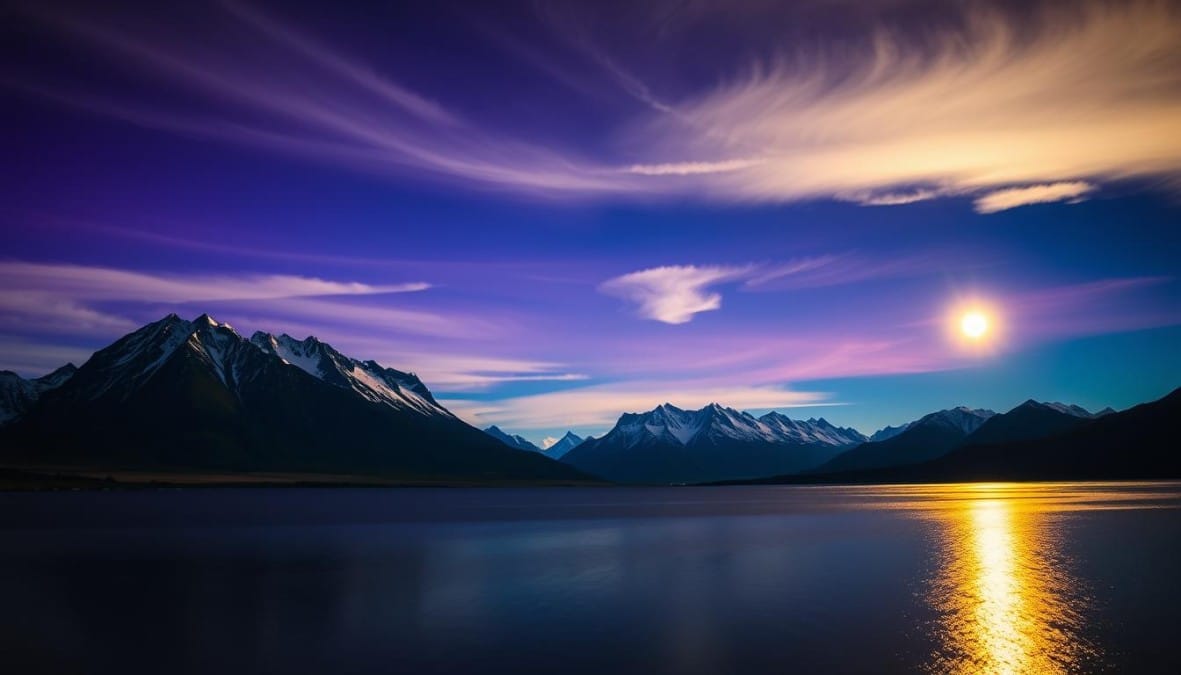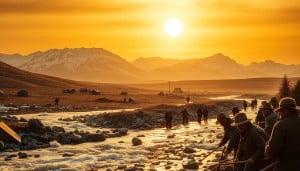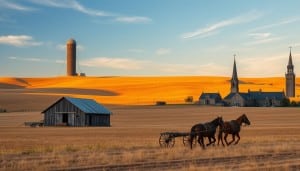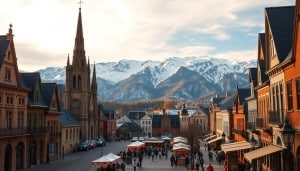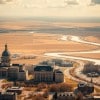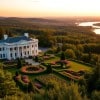The Northwest Territories span over one million square kilometers but have fewer than 45,000 people. This place is a land of stark contrasts and extremes. Have you heard about Aulavik National Park there? It’s a spot where daylight lasts more than three months, known as the Land of the Midnight Sun. This phenomenon is key to the history and culture of the area’s people.
In the Northwest Territories, the Indigenous history is full of stories. These tales blend with the bright summer nights. In places like Fort Simpson, locals enjoy the light nights from May to July. They do things like playing golf at midnight or celebrating National Indigenous Peoples Day under a never-setting sun.
The impact of the Midnight Sun is vast. It affects wildlife like caribou, making them sleep less, and helps sunflowers grow in greenhouses. Arctic explorers were also attracted to this area by the constant sunlight. Even today, the Midnight Sun influences life here, from animal behaviours to people’s joyful celebrations.
Overview of the Northwest Territories
Come and discover the vast Northwest Territories. This special part of Canada tells a story of survival and growth. Its land and climate have shaped its unique place in Canada’s history.
The economy of the Northwest Territories is linked to its large land and changing weather. The area’s growth shows the hard work and cleverness of its people.
Geography and Climate
The Northwest Territories is full of natural beauty and complex ecosystems. It has lush forests, frozen tundra, and countless lakes and rivers. These waterways have always been important for travel and life here.
The weather here changes a lot. Summers have days that never end, while winters are long and dark. These extreme conditions affect the way people live and celebrate their culture.
Indigenous Peoples
Indigenous peoples are key to the Northwest Territories. They honor their rich history and vibrant cultures through many festivals. Their wisdom and ways of living greatly shape the community and economy.
Economic Overview
Over time, the Northwest Territories’ economy has changed a lot. It’s moved from traditional living to having varied jobs. Now, mining, tourism, and local arts are important. The future looks to be focused on sustainable growth.
The Northwest Territories has come a long way. Despite tough weather and a large area, it’s filled with promise. Its strong community sees a bright and sustainable future ahead.
Early Indigenous Inhabitants
Exploring the Indigenous history of Northwest Territories reveals a world of vibrant cultures. These traditions show a deep bond with the land. They include everything from following the Midnight Sun to holding big community parties.
These people’s ways of living were closely connected to nature’s rhythms. This shows a deep respect for nature. It’s something we can still learn from today.
- Cultures and Traditions : The rich culture of the Indigenous groups in the Northwest Territories shines at events like the National Indigenous Peoples Day. This day brings to life old customs through dance, music, and storytelling. It helps keep their heritage alive, teaching young people about their history.
- Language and Art : Language is key to passing on the history and wisdom of the people. In the Northwest Territories, Indigenous languages hold cultural identity. Art is also vital. Activities like wood carving and beading are not just art. They also help pass down important knowledge and skills.
Through efforts like the Adäka Cultural Festival in Yukon, these communities keep their art alive. They make sure their traditions stay strong and relevant today.
We’re excited to share and honor the rich history and continuous contributions of the Indigenous peoples in the Northwest Territories. They are a key part of our country’s diverse culture.
European Exploration and Colonization
European explorers stepping into the Northwest Territories opened a new chapter in its history. These pioneers had a huge impact on the area. They were drawn by the hope of finding new trade routes and the untouched wilds of the North.
The fur trade era in Northwest Territories stands out. It wasn’t just a way to make money; it changed how indigenous people and newcomers interacted. The fur trade wove new connections into the fabric of Northern society. These connections have left a mark that we can still see today.
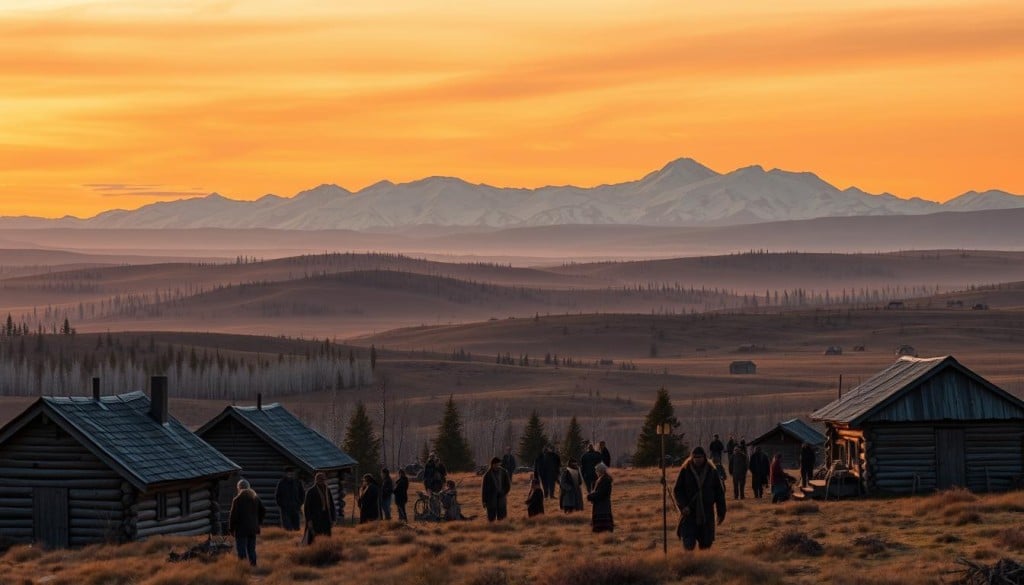
The fur trade era was a time of both growth and challenges. Trading posts brought people together for trade, sharing ideas and cultures. This led to new partnerships and sometimes, conflicts.
### Table of Significant Trading Posts
| Location | Established | Significance |
|---|---|---|
| Fort McPherson | 1840 | Major stop along the Dempster Highway, known for its vibrant community gatherings and cultural exchange. |
| Fort Providence | 1860 | Initially a mission, it became a critical trading site, bridging interactions between European traders and indigenous communities. |
| Fort Good Hope | 1805 | Strategically located on the Mackenzie River, pivotal for the transportation networks during the fur trade era. |
We remember the stories of those who shaped the Northwest Territories. Let’s think about how human efforts and caring for our environment have made our region what it is. Knowing our history helps us value our shared heritage deeply.
Formation of the Northwest Territories
The formation of the Northwest Territories is a story filled with key moments and laws. This journey shows how the area became an important part of Canada. The effort of early leaders played a big role.
As the Northwest Territories moved towards being part of Canada, many laws came into play. These laws helped shape the area politically. They made sure the rich resources and various cultures were well taken care of.
- Historical Development: The growth into today’s Northwest Territories was mainly because of the fur trade. There was a big need for rules to handle the industry’s growing needs.
- Key Legislation: The Northwest Territories Act of 1870 was a major step. It officially made the area a part of Canada. This law set up how the territory would be managed.
The steps taken towards joining Canada were important. They made joining Canada easier and kept the local cultures and environment in mind. Understanding how the Northwest Territories were formed helps us see the mix of leadership and culture that makes the area special today.
The Gold Rush Era
The Gold Rush was a key time in the Northwest Territories’ history . It brought many people and needed big changes in infrastructure. This era was not just about finding gold. It also helped the region grow and develop even today.
With the Gold Rush, many people came to the Northwest Territories. Small settlements grew into big towns fast. This growth meant more services and places for people to live and work were needed.
| Year | Population Before Gold Rush | Population During Gold Rush |
|---|---|---|
| Pre-1890s | Minimal | N/A |
| 1896-1899 | Approx. 200 | Over 30,000 |
| Post-1900 | Stabilizing | Decreasing but significant |
Because so many people came, the area needed better roads, bridges, and railways. They had to build quickly to support mining and the movement of goods. Telegraph lines also got set up, improving communication big time.
The Gold Rush era’s influence on infrastructure in the Northwest Territories was huge. It shows how big events can really shape a place. It was a golden time in Canada’s history.
Modern Governance
The journey from early political structures to today’s governance in the Northwest Territories shows true grit and flexibility. The area’s political history has merged with the principle of modern governance. This blend aims to honor the voices of everyone, including Indigenous groups, while tackling unique local challenges.
Various political reforms have molded the Northwest Territories’ current government setup. Understanding this change is crucial for valuing our growth and planning ahead.
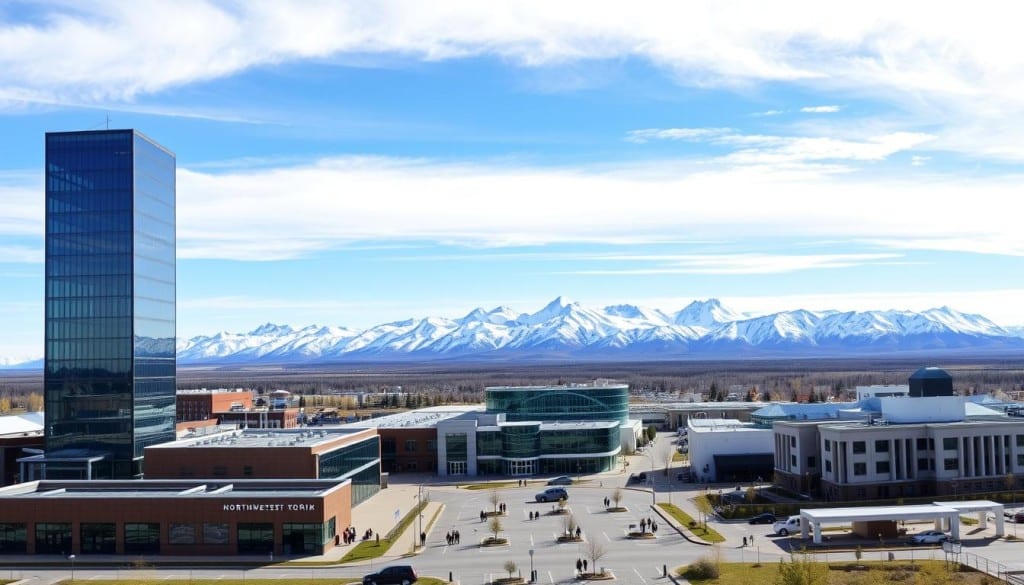
The political scene of the Northwest Territories has hit key milestones. Since joining Canada, every reform step has aimed at better representation and efficiency.
- Inclusion of Indigenous perspectives in governance mechanisms.
- Gradual decentralization providing more power at local levels.
- Legislative reforms fostering greater transparency and accountability.
Current Administrative Structure
Today, the Northwest Territories’ governance is built to handle its vast area and varied cultures. It ensures every region can contribute to their management, from local councils to the territory government.
- The Territorial Government, which handles territory-wide governance, policy-making, and administration.
- Regional Governments that focus on specific areas, ensuring that local priorities and issues are addressed effectively.
- Community Governments which are closely connected with residents, providing services directly influenced by community needs.
This ongoing effort to improve governance makes sure it meets everyone’s needs, reinforcing modern governance in the Northwest Territories.
Cultural Heritage
The Northwest Territories’ cultural heritage shines through vibrant Indigenous festivals and traditions. This unique region’s rich tapestry is celebrated by locals and visitors alike. They love the celebrations that honor ancient customs and the territories’ natural beauty.
In these territories, traditions like the spring Goose Break show the close bond between land and people. These events let people reconnect with nature and pass down traditional skills and stories.
Celebrations and Festivals
Indigenous festivals in the Northwest Territories attract people from all over the world. The events, filled with traditional music, dance, and crafts, showcase the communities’ deep cultural roots. National Indigenous Peoples Day, with its all-night festivities under the midnight sun, is a prime example. It showcases the region’s unique culture and geography.
Art and Music
The local art scene is shaped by nature and Indigenous culture, playing a key role in community life. Through storytelling, music, or visual arts, the art in the Northwest Territories shares both old and new stories of its diverse people.
| Festival | Date | Activities |
|---|---|---|
| Long Sun Nights Festival | June 21-23 | Music, dance workshops, traditional games |
| Great Northern Arts Festival | July 10-19 | Visual arts, sculptures, indigenous crafts |
| Snowking Winter Festival | March 1-31 | Ice sculpture, snow castles, live music |
By exploring the Northwest Territories’ cultural heritage, we dive deep into its community spirit. This exploration enriches visitors and helps keep local customs and artistic practices alive for future generations.
Natural Wonders and Tourism
Discover the History of Yellowknife and the larger Northwest Territories, a place where Midnight Sun tourism amazes all who visit. Experiencing the sun high in the sky at midnight is a rare and special thing. It’s something that really makes our region stand out.
In the Northwest Territories, serene lake views and the northern lights await. These wonders not only make the history of Yellowknife richer. They also attract people from all over wanting to see the Midnight Sun and more.
- Hiking through untouched wilderness
- Canoeing across vast, mirror-like lakes
- Fishing in abundant, crystal-clear waters
- Photography tours capturing surreal landscapes
Guests have lots of choices for outdoor activities in Northwest Territories . There’s something for everyone, making every visit unforgettable. Whether you love challenging adventures or relaxed family walks under the Midnight Sun, we have it all.
Future Prospects
The Northwest Territories are at a turning point, balancing growth with protecting our beautiful environment. We take on the role of guardians for this magnificent area, ready to shape its future. Our history in economic development isn’t just about our past; it’s a guide for a sustainable economic future.
We have the chance to use our natural resources wisely, keeping our commitment to the environment. This ensures the area thrives for many future generations.
In the Northwest Territories, opportunities in mining, renewable energy, and tourism are plenty. They promise a brighter economy for everyone. By blending traditional knowledge with new ideas, we enhance our land’s value. Supporting local businesses and partnerships shows our Canadian pride and promotes national craftsmanship.
We also prioritize our environment over economics. The beauty of the Midnight Sun and untouched landscapes defines us. So, we invest in keeping our land safe and practicing sustainability. Our vision includes a balance that protects our natural treasures as we grow economically.
This way, the Northwest Territories will remain a place of both chances and care. It will be a future that values our history and natural wonders.

